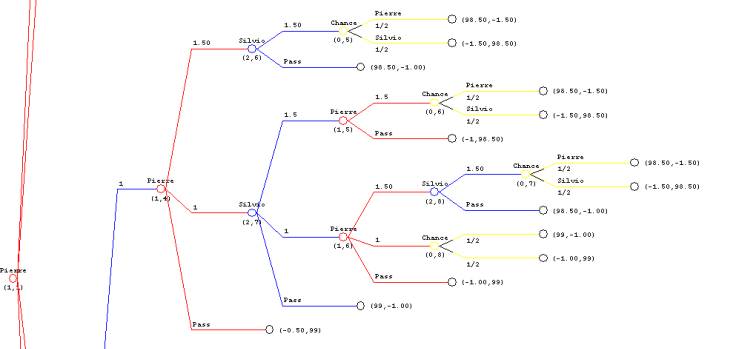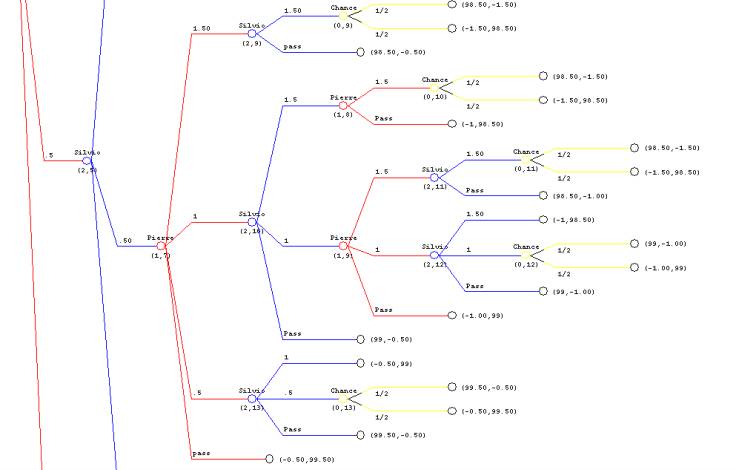All Pay Auction
Dr. Buck offers to auction this 100 Euro note to the highest bidder. The twist is that even losers have to pay their bid.
A Sealed Bid Normal Form Representation of the Game.
Assumptions
1. There are two players: Pierre and Silvio.
2. Each player submits a single bid. They can bid €0, €0.5, €1, €1.50
3. The Euro note goes to the highest bidder, but all bidders must pay.
4. A tie is settled by the flip of a coin, but all bidders must pay.
The normal form of the game looks like:
| Pierre | |||||
| €0 | €0.5 | €1 | €1.5 | ||
| Silvio | €0 | 50,10 | 0, 99.50 | 0, 99 | 0, 98.50 |
| €0.5 | 99.50, 0 | 49.50, 49.50 | -0.5, 99 | -0.5, 98.50 | |
| €1 | 99, 0 | 99, -0.5 | 49, 49 | -1, 98.50 | |
| €1.50 | 98.50, 0 | 98.50, -0.5 | 98.50, -1 | 48.50, 48.50 | |
Although €0 is dominated by €1.50, there are no other dominated strategies. The equilibrium in the game is found by looking at best responses. The best responses are underlined. Where there is a coincidence of best responses, both payoffs in a cell are underlined, there is a Nash equilibrium.
| Pierre | |||||
| €0 | €0.5 | €1 | €1.50 | ||
| Silvio | €0 | 50,10 | 0, 99.50 | 0, 99 | 0, 98.50 |
| €0.5 | 99.50, 0 | 49.5, 49.5 | -0.5, 99 | -0.5, 98.50 | |
| €1 | 99, 0 | 99, -0.5 | 49, 49 | -1, 98.50 | |
| €1.50 | 98.50, 0 | 98.50, -0.5 | 98.50, -1 | 48.5, 48.5 | |
There is only one Nash equilibrium in the game. The expected revenue to the seller/auctioneer is $3. The expected gain to either bidder is €48.50, but they won't know their actual payoff until the bids are unsealed; one of them will get €98.50 and the other will lose €1.50.
An Extensive Form of the Game:
Assumptions
1. There is a single unit of the good, a 100 Euro Note, to be sold.
2. There are two buyers, Pierre and Silvio, who take turns bidding. Pierre goes first. At each turn the bidder can either raise, or meet the current price, or pass. A bid of pass means forfeiting any money bid to that point and losing the good.
3. The minimum acceptable bid is $.50. Each subsequent bid must be in increments of $.50
4. Each player has $1.50 with which to play.
5. When a bidder passes then he is out of the auction, play ends, and the Euro note goes to the highest bidder.
6. If a player bids the same amount twice then they can no longer raise their own bid.
7. If bidding results in a tie then the Euro note is awarded on the basis of a flip of a fair coin and everyone pays their bid.
Questions
Use backward induction to find the solution to the game.
What are the payoffs to the bidders and to Dr. Buck?
 |
 |
 |
 |
This is a little hard to read, but if you have GAMBIT on your machine then youcan download the game file by right clicking here. The solution to the game is for Pierre to open with a bid of .50, Silvio responds with a bid of 1, Pierre responds with a bid of 1, Silvio replies with a bid of 1, Pierre responds with a bid of 1, and the game is resolved by the flip of a coin. If you first figure out the expected payoff in each 'chance' subgame, then use backward induction to you will arrive at this solution. In this solution the seller/auctioneer earns 2. The players have to wait until the toss of the coin to find out who wins 99 and who wins -1.